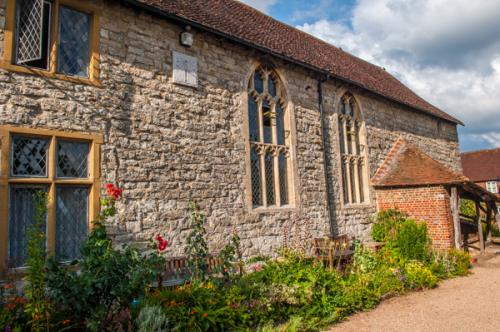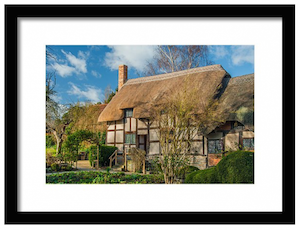
Cobham College is not a college in the modern sense, but an almshouse for poor and elderly people, built from the remains of a 14th-century college of priests, established to pray for the souls of its founder and his family.
History
In 1362 John de Cobham, the 3rd Baron Cobham and lord of the manor of Cobham, Kent, founded a college of priests in Cobham, beside the parish church. Baron Cobham gave money to sustain five priests, one of whom served as Master of the college. The priests' job was to pray for the souls of the founder and his family and speed their passage to heaven.
A residence for the priests was built beside the parish church of St Mary Magdalene, with a covered passage leading to the church, where the priests held regular masses. The residence had chambers for each of the five priests as well as a communal hall. The College buildings may have been designed by the Royal Mason, Henry Yevele, who also worked on the neighbouring church.

Most colleges of priests were suppressed by Henry VIII during his Dissolution of the Monasteries, but Cobham College is somewhat unusual in that the priests surrendered voluntarily to the college patron, George Brooke, the 9th Baron Cobham. This meant that the college buildings and its holdings did not pass to the monarch's Court of Augmentation, but stayed in the Brooke family.
The college buildings were left to decay until 1597, when Sir William Brooke, 10th Baron Cobham and Lord Chamberlain to Queen Elizabeth I, left money in his will to transform the college into an almshouse that would provide accommodation for 21 poor and elderly local people.
Each resident of the almshouse had a dwelling with a single room at ground floor and a single room at first-floor level. Each of these dwellings had its own entrance door at ground level. A brass plate was fixed to the wall above the door and inscribed with the name of the parish from which the resident had come.

The Brooke family's ownership of the college property was confirmed by an Act of Parliament called the Cobham College Act 1597, or 'An Acte for the establishment of the new Colledge of the Poore at Cobham in the Countie of Kente.' to be precise. The act was given royal assent on 9 February 1598.
The College stayed essentially unaltered for centuries and it was not until 1956 that electricity, running water, and sewer drainage was added to the medieval structure.
In 1981 the 16th-century layout was modernised and today the almshouse offers affordable accommodation for 29 residents in one-bedroom dwellings. There is a communal garden, laundry, and lounge, plus space for resident staff. The almshouses are under the care of a charity known as The New College of Cobham.

What to See
The College is arranged with four wings creating an enclosed courtyard, or quadrangle.
The quadrangle buildings are two-storeys high with a hall on the south side of the square. The hall is faced with flint but the other three sides are made of coursed stone and the chimneys are of brick. The gabled roof is of tile and the windows are casement style with stone mullions. The hall windows are in Perpendicular Gothic style.
In the south wall of the quadrangle is a water pump. A plaque above the pump commemorates its gift to the College by the Countess of Darnley in 1824.

The hall has its original 14th-century timber roof and boasts a 1598 fireplace with a stone hood. Beneath the hall is an undercroft with a pillar that originally supported a central hearth in the hall above.
The most obvious exterior feature is a timber porch with a very slanted tile roof on the south facade. This porch gives access to the hall and the undercroft. A processional passage links the College to the parish church. At each end of the passage is a ruined medieval archway. The passage originally linked to the church chancel via a doorway, now blocked.
South of the College you can see the ruins of a now-lost building, thought to have been the College kitchen.
Visiting
The College is occasionally open to visitors, and the exterior is accessible at any time. Even when the College interior is not open, you can easily look into the quadrangle and see the arrangement of residences around the courtyard. It was not open to visitors on the day we came, but we were still able to walk around the exterior and peer into the courtyard.
About Cobham College
Address: Cobhambury Road,
Cobham,
Kent,
England, DA12 3BG
Attraction Type: Historic Building
Location: Beside the parish church on Cobhambury Road
Website: Cobham College
Location
map
OS: TQ669683
Photo Credit: David Ross and Britain Express
HERITAGE
 We've 'tagged' this attraction information to help you find related historic attractions and learn more about major time periods mentioned.
We've 'tagged' this attraction information to help you find related historic attractions and learn more about major time periods mentioned.
Find other attractions tagged with:
NEARBY HISTORIC ATTRACTIONS
Heritage Rated from 1- 5 (low to exceptional) on historic interest
Cobham, St Mary Magdalene's Church - 0 miles (Historic Church) ![]()
Owletts - 0.2 miles (Historic Building) ![]()
Cobham Hall - 0.9 miles (Historic House) ![]()
Cobham Mausoleum - 1.5 miles (Historic Building) ![]()
Milton Chantry - 3.4 miles (Historic Building) ![]()
Temple Manor - 3.9 miles (Historic Building) ![]()
Paddlesworth, St Benedict's Church - 4 miles (Historic Church) ![]()
Rochester Guildhall Museum - 4.5 miles (Museum) ![]()



